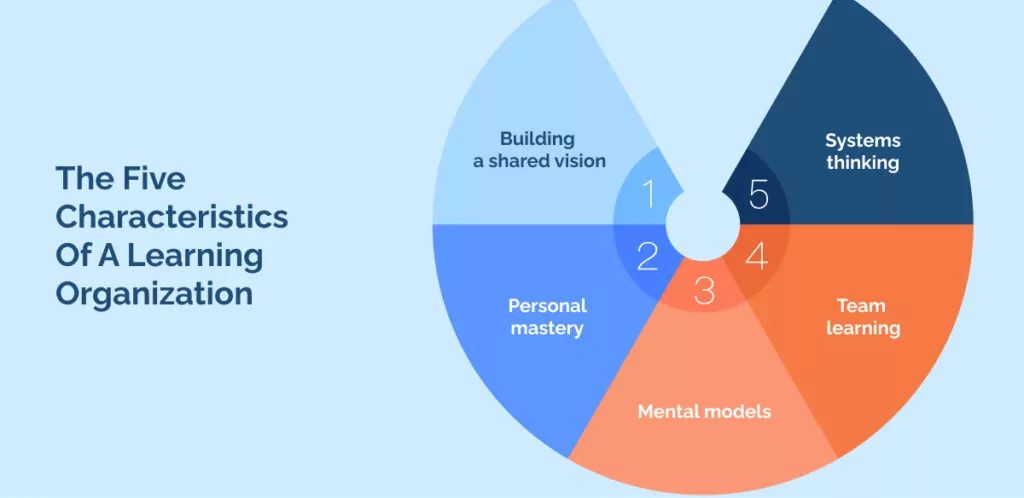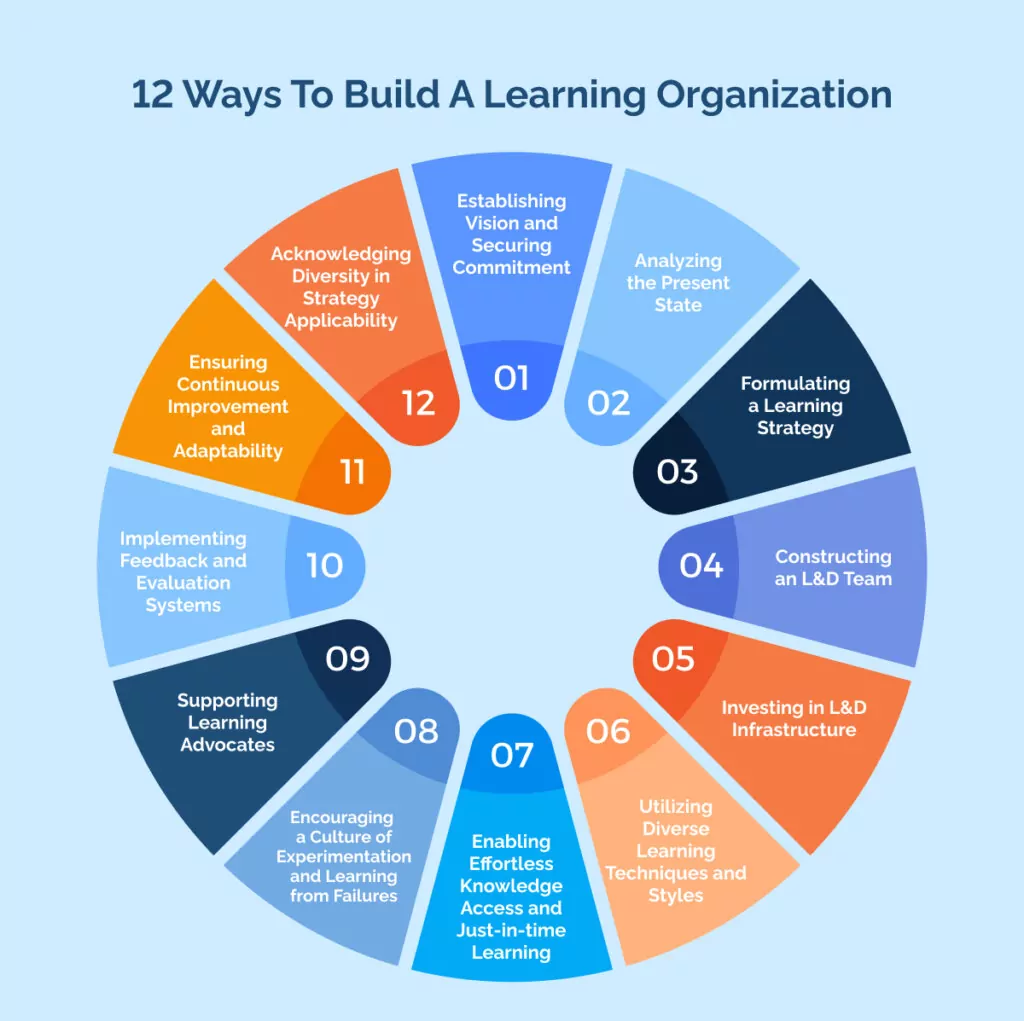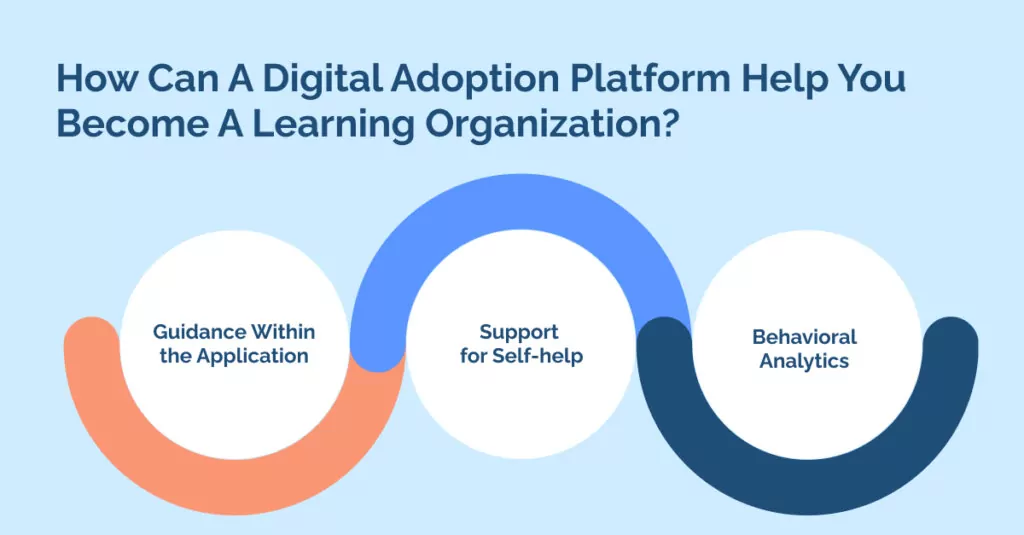
A learning organization is a company that fosters a culture of continuous learning and development.
It facilitates the personal and professional growth of its members through knowledge transfer, encourages exploration of new ideas, and constantly transforms itself. This process involves total employee involvement in collaboratively conducted activities, making learning an ongoing and creative endeavor.
Learning organizations cultivate an environment where individuals can enhance their ability to generate desired outcomes, nourish innovative and broad thinking patterns, and persistently explore collective learning methodologies.
The concept of a learning organization gained prominence in 1990 when author and systems scientist Peter Senge introduced businesses to it through his “The Fifth Discipline” book.
Navigating through today’s dynamic and perpetually changing business environment can encourage businesses to evolve, innovate, and anticipate the next wave of change management – emerging digital technologies or market innovations.
Such a landscape necessitates a pivotal transition in how companies formulate and execute their learning and personal development strategies, steering them toward becoming agile learning organizations.
By the end of this article, you will learn:
- What a learning organization is, including its five disciplines
- What type of organizational practices make a learning organization
- The benefits of a learning company
- Key learnings from existing learning organizations
- 12 ways to help you make a fundamental shift toward lifelong learning
- How a digital adoption platform can encourage knowledge acquisition and change management in digital transformation
What Is A Learning Organization?
A learning organization champions a culture prioritizing continuous learning and knowledge creation across every level. It embodies an organizational model that underscores the crucial nature of embracing change, assimilating new knowledge, and employing insights to amplify performance and realize strategic goals.
The whole organization partakes in the processes of obtaining, disseminating, and implementing knowledge, with an emphasis on innovation, teamwork, and agile responses to both challenges and opportunities.
Learning organizations advocate for transparent communication, experimentation, and introspection, valuing their workforce’s cumulative intelligence and learning aptitude.
What Are The Five Characteristics Of A Learning Organization?

In his book, Peter Senge defines the key characteristics or five disciplines of learning organizations:
Building a shared vision
A shared vision is a crucial trait of a learning organization, forming a unified objective and possessing the capability to inspire innovation and imaginative thought.
When a vision is collaboratively crafted, individuals perceive their ideas as cherished and believe they contribute toward a mutual objective.
Personal mastery
Personal mastery pertains to an individual’s dedication and ongoing pursuit of self-growth, learning, and professional development. It fosters a mentality dedicated to perpetual learning and aims for exemplary performance in one’s selected profession or specialty.
Mental models
Mental models encompass deeply ingrained assumptions, generalizations, or perceptions that shape our understanding of the world and dictate our actions.
However, such models can either advance or obstruct learning and organizational development.
In a learning organization, emphasis is placed on uncovering and questioning mental models, prompting individuals to scrutinize their foundational assumptions and predispositions.
This vital characteristic paves the way for novel viewpoints, innovation, and enhanced problem-solving, ultimately bolstering the organization’s capacity to adapt and learn in a swiftly evolving environment.
Team learning
Team learning embodies a cooperative process in which team members unite to proactively exchange knowledge, experiences, and insights, thereby augmenting the collective learning and effectiveness of the entire team.
Learning organizations can tap into their teams’ collective wisdom and abilities through team learning, subsequently elevating problem-solving, innovation, and comprehensive team performance.
Systems thinking
The fifth discipline is systems thinking, which involves perceiving the organization as a sophisticated and interlinked system in which diverse components, processes, and individuals interplay and influence each other.
Utilizing systems thinking, a learning organization can pinpoint systemic elements that affect learning efficacy, tackle the root origins of challenges, use interrelated components for enhancement, and promote a comprehensive methodology for microlearning and organizational progression.
How Can You Identify A Learning Organization?
You can identify a learning organization through its actions of championing learning across every echelon, implying that management and executive-level employees must embody a strong learning culture and cultivate innovative thinking from the executive suite to the production area.
Moreover, all employees are made to feel secure in expressing their thoughts, taking risks, evaluating failures, and contesting prevailing ideologies. Diversity is valued, and a receptiveness to fresh ideas is present, for it counteracts stagnation and spurs innovation.
Learning organizations also exhibit a profound allegiance to learning processes and strategies. They gather varied data from many sources, both internal and external, analyzing and deciphering it to address issues and discern trends.
Crucially, leaders in a learning organization are continually learning themselves. They model the behavior of others and enable the learning environment, in addition to learning processes and methodologies.
Learning organizations also glean lessons from their errors and actively participate in problem-solving to swiftly pivot toward more effective solutions.
Benefits Of A Learning Organization

Let’s take a look at some of the paramount advantages of a learning organization:
Empowering Employees for Enhanced Productivity
When thoroughly engaged and motivated to deepen their understanding of their work, domain, and company, employees feel better prepared to thrive in their roles and exhibit elevated productivity.
Boosting Employee Engagement and Drive
Learning organizations prioritize the personal and professional growth of their employees. This commitment to continuous learning and advancement instills a sense of engagement, fulfillment, and motivation within the workforce, boosting productivity, employee flow, and retention.
Mitigating Employee Attrition
Learning organizations inspire staff members to engage deeply, forge a potent community, and empower teams to take pride in their contributions and positions within the firm.
These factors symbiotically reinforce each other, enticing more employees to remain with a company for longer, thus minimizing expenses related to employee turnover.
Facilitating Knowledge Sharing
Efficiency is augmented, and connections are forged in learning organizations through knowledge sharing.
This eradicates employees’ need to squander vital energy on redundant efforts, furthers comprehension, and ensures everyone possesses a lucid understanding of the prerequisites for success.
Amplifying Innovation and Creativity
Encouraging experimental approaches, risk-taking, and pursuing novel ideas are hallmarks of a learning organization.
This nurtures innovation and creativity across the board, culminating in the genesis of new products, services, and processes that afford a competitive advantage.
Enhancing Problem-Solving and Decision-Making Proficiency
Learning organizations advocating for critical thinking, creative endeavors, and collaboration pave the way for refined problem-solving and decision-making capabilities.
Employees are encouraged to think outside the box, explore diverse viewpoints, and employ their expertise and abilities to navigate intricate challenges.
What Are Some Examples Of A Learning Organization?
Examples of modern organizations exemplifying mastery in lifelong learning and product adaptation encompass:
Amazon: Championing Self-Initiated Growth
In Amazon, continuous personal development is paramount. For instance, each employee is envisaged to embody ownership.
When employees discern any issue impacting the customer experience or conceive an improvement idea, they are encouraged to solve problems proactively, irrespective of their expertise. Various awards, like the “Just Do It,” have been instituted to acknowledge such proactive behaviors.
Pixar: Cultivating Team Learning and Discarding Presumptions
At Pixar, embracing team learning and relinquishing assumptions and judgments is vital.
For example, teams are systematically motivated to share their in-progress work to counteract a culture obsessed with perfectionism, which can stifle innovative ideas and normalize the reception of feedback.
This strategy engenders an enriched atmosphere of playful exploration and security, nurturing enhanced creativity.
12 Ways To Build A Learning Organization

Developing a learning organization demands deliberate strategies and actions to cultivate a perpetual learning and evolution culture.
Here are several pivotal strategies to nurture a learning organization:
Establishing Vision and Securing Commitment
Leadership’s role in sculpting an organizational learning culture is vital. Top management must comprehend and convey the significance of continual learning while championing its integration into the organizational culture.
Analyzing the Present State
Execute a thorough analysis of the organization’s current learning practices, systems, and culture. Recognize strengths, weaknesses, and opportunities for advancement. This analysis will be a foundation to gauge progress throughout the learning journey.
Formulating a Learning Strategy
Utilizing the findings from the assessment, formulate a strategy for individual and collective learning and development that correlates with the organization’s overarching goals and objectives.
Identify primary focus areas, such as knowledge management, procurement, collaboration, and innovation, and describe distinct initiatives to be employed.
Constructing an L&D Team
Assemble a team from diverse organization sectors to devise and implement L&D initiatives.
These team members should utilize survey data, personal experiences, and hard data from L&D tools to steer their efforts while consistently evaluating progress and adjusting for the future.
Investing in L&D Infrastructure
Supply the essential infrastructure, tools, and resources to back learning initiatives. This includes investing in learning management systems, knowledge-sharing platforms, digital adoption platforms, online libraries, and pertinent training materials.
Each platform and tool plays a crucial role in enabling and streamlining the learning process across the organization.
Utilizing Diverse Learning Techniques and Styles
Different employees thrive with various learning conditions and methods. Understanding their learning styles—considering factors like training objectives, goals, cost, and timeline—is crucial for L&D teams to identify effective training methods for the workforce.
Enabling Effortless Knowledge Access and Just-in-time Learning
Adapt to modern employees’ expectations for flexibility in their working and learning conditions.
Ensure L&D projects embody agility and flexibility, allowing team members to engage in suitable lessons at their convenience, enhanced by L&D software that supports mobile compatibility and user-friendly access.
Encouraging a Culture of Experimentation and Learning from Failures
Foster an atmosphere that values experimentation and learning from missteps. Encourage employees to undertake calculated risks, explore innovative strategies, and learn from triumphs and failures.
Advocate for a growth mindset that perceives failures as opportunities for refinement and innovation.
Supporting Learning Advocates
Identify and fortify learning advocates within the organization. These individuals can champion learning, aid their colleagues’ learning paths, and facilitate knowledge exchange.
Offer them avenues for further personal growth, create an open forum to discuss issues, and acknowledge their contributions to the learning culture.
Implementing Feedback and Evaluation Systems
Incorporate feedback systems and evaluation frameworks to assess the efficacy of training and identify areas needing improvement.
Implement post-training surveys to collect feedback, monitor learning outcomes, and examine the impact of learning on organizational performance.
Ensuring Continuous Improvement and Adaptability
Learning organizations perpetually evolve. Review and fine-tune learning strategies, programs, and processes, considering feedback, emerging trends, and shifting organizational requirements.
Adopt a culture of ongoing improvement and adaptability to ensure organizational relevance and resilience amidst rapid changes.
Acknowledging Diversity in Strategy Applicability
Managers must respect departmental processes and practices differences while aiming to build a learning organization. Units may vary in their objectives or learning maturity.
A uniform strategy for building a learning organization is typically ineffective due to the possible variances in local learning cultures among units. Ensuring sensitivity towards diverse cultural aspects of learning, which can significantly vary, is crucial.
How Can A Digital Adoption Platform Help You Become A Learning Organization?

A Digital Adoption Platform (DAP) strengthens the learning capabilities of organizations that favor continuous learning by delivering a thorough solution that encompasses:
- Guidance Within the Application: DAPs furnish in-app assistance by delivering context-specific, immediate support within the digital resources employees utilize. This guidance assists employees in maneuvering through intricate workflows, comprehending tool functionalities, and efficiently accomplishing tasks.
- Support for Self-help: DAPs empower users to autonomously discover answers, troubleshoot issues, and navigate challenges without dependence on external support avenues.
Employees can access pertinent information and guide themselves whenever they face hurdles through a knowledge repository, FAQs, and searchable documentation.
- Behavioral Analytics: DAPs capture and scrutinize user interactions within digital resources, tracking and recording user activities such as clicks, navigational patterns, and task achievements, offering crucial insights into how employees engage with their tools.
These analytics help pinpoint usage trends, bottlenecks, and opportunities for enhancement. By dissecting user behavior, organizations understand user inclinations, challenges, and skill deficiencies.
This allows them to implement data-informed decisions to uplift user experience and propel continuous learning initiatives.
The Future Of Learning Organizations
A learning organization encourages a continuous learning culture so that it can perpetually evolve for the better. The foundational principle is that amplifying employee skills directly correlates with achieving sought-after results.
Peter Senge highlights the pivotal role of personal mastery, collaborative learning, a collective vision, mental paradigms, and systems thinking in evolving into a learning organization.
This manifests in a corporate environment where leaders and team members are ardently committed to constant learning from various sources, striving toward peak performance.
Embarking on your enterprise’s journey toward nurturing an organization deeply embedded in continual learning and enhancements at every tier can begin by deriving insights from the five principles of a learning organization and observing companies that inherently embody these attributes.
Embarking on the journey of becoming a learning organization involves several key steps.
Here’s a brief outline to guide you through the process:
- Start by examining your organization’s current learning practices and develop a clear vision and strategy for implementation.
- Establish a Learning and Development (L&D) team to lead the transformation of your organization.
- Consider integrating L&D tools to facilitate and simplify the digital adoption journey for your employees.
- During this transition, gather and incorporate feedback from your team members to continuously refine and improve the learning process.
- Learn from failures and recognize team members who actively participate in this culture of continuous improvement.
WalkMe Team
WalkMe spearheaded the Digital Adoption Platform (DAP) for associations to use the maximum capacity of their advanced resources. Utilizing man-made consciousness, AI, and context-oriented direction, WalkMe adds a powerful UI layer to raise the computerized proficiency, everything being equal.



